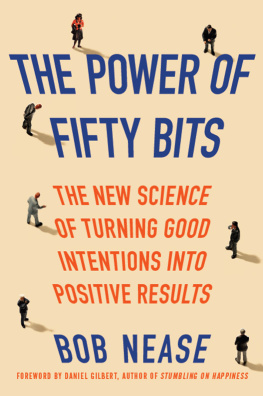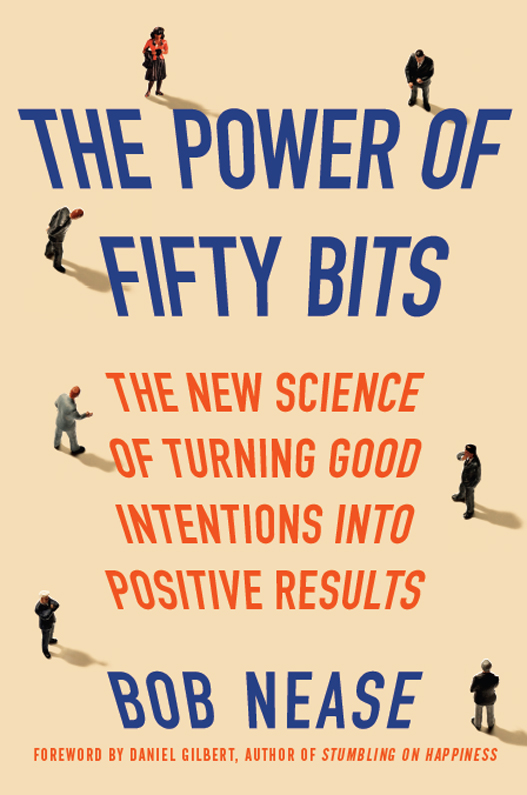For Delight and Addie
Every body continues in its state of rest,
or of uniform motion in a right line,
unless it is compelled to change that
state by forces impressed upon it.
Contents
Guide
H umans often make a mess of things. Those things include our relationships, our businesses, our finances, our health, and our planet. Our messes wouldnt be so puzzling if we didnt care, or if we didnt know any better. But we do, and we do. We want happy marriages and we know that philandering is a poor way to get them, but then we go off and do it anyway. We want carefree retirements and we know that saving money is the only way to get them, but somehow we just never get around to it. Instead of making choices that we know will behoove us, we make choices that leave us with no hooves at all. Why?
Philosophers, psychologists, and economists have spilled a lot of ink in the last few centuries trying to explain this puzzling tendency. Fortunately, Bob Nease isnt one of them. Rather, Bob is an engineer who, until recently (when he and his wife quit their jobs and moved to Italy to devote themselves to making wine), was the chief scientist at one of the worlds largest pharmacy benefits management companies. His company had millions of members who were faced with choices about their own medical care, and Bob thought that his job was to help them make those choices intelligently. But when he tried to save them time and money, or when he tried to spare them worry and confusion, they often ignored his well-meaning attempts and sometimes even actively resisted them. Bob didnt want to explain this puzzling tendency. He wanted to fix it.
So Bob read all the books that the ink-spillers had written, and then started doing what engineers do best: tinkering. He designed programs and systems that used basic principles of human behavior to help his companys members make better decisions, and then tested those programs and systems in large-scale experiments. He kept the ones that worked, tweaked the ones that didnt, and then tested them again. And again.
Now, over the years, my tinkering has led to exactly one recipe for the perfect martini (combine frozen gin with absolutely nothing else ever) and a fairly reliable method for keeping the sous vide bag submerged in a pot of boiling water (hint: magnets). Bobs tinkering actually saved lives. As a result of his innovations, people who needed to take medicine took medicine. People who needed to get more exercise got more exercise. People who needed to see their doctors saw their doctors. And in the process of fixing the puzzling tendency, Bob developed a fascinating theory about where it came from in the first place. Thats what this book is all about. In many ways, it is yet another one of Bobs cleverly engineered systems, expertly designed to hook you with an enigmatic title, hold you with delightful stories and deep ideas, and ultimately leave you better than you were beforewiser about people in general, and about yourself in particular.
In Italy, they toast with the word salute, which means to health. It seems that Bobs work, Bobs book, and Bobs wine are all dedicated to the same basic proposition. I invite you to pour yourself a glass of Fifty Bits, sit back, and enjoy.
S everal years ago, my wife, Gina, and I were in Atlanta visiting some of her friends from the Centers for Disease Control and Prevention. Gina has a PhD in epidemiology and has worked on a variety of very challenging programs to improve public health. These initiatives include efforts to eradicate polio in Nepal, HIV in Malawi, and sodium in my diet.
During our second night in Atlanta, a bunch of us went out to dinner. Based on my past experience with the group, I knew wed be splitting the check. If youre a food lover like me, that really complicates things. I love to eat, but because I knew that the cost of whatever I ordered would be borne by everyone else in the group, I needed to make sure I didnt get carried away. (I wanted the shrimp carpaccio, the porcini flan, and the rib-eye steak with horseradish whipped potatoes, but I realized that the risotto and small green salad would be more prudent.)
This consideration was completely lost on another member of the dinner party, a fellow whom I will call Jack. What I recall most vividly about the evening was what Jack ordered. And ordered. And ordered some more. He drank faster than everyone else, treated himself to an appetizer and a salad, and chose one of the most expensive entrees. For dessert, he had crme brle and a cappuccino and finished off the dinner by ordering a snifter of port. I nearly jumped across the table.
I fumed in silence as my wife and I drove back to the hotel in our rented car. My fists gripped the steering wheel, my knuckles turned white, the vein in my forehead pulsed, and my jaw clinched. When Gina patted my shoulder and asked, Its Jack, isnt it? I nearly drove into oncoming traffic. No kidding, its Jack. Hed been poorly behaved all night, single-handedly running up a tab that we would all have to pay.
A FEW THINGS YOU SHOULD KNOW ABOUT ME
That dinner with Jack had a big impact in my professional life. To understand why, you need a little background about me. My undergraduate degree is in electrical engineering, and I come from a long line of clear-thinking, quantitative, and rational people. My father got his doctorate in electrical engineering from MIT and went on to become the chief scientist at Rockwell International (now Boeing); my mother had her bachelors degree in education from Boston University. My grandmother on my moms side was a teacher, my dads father was adept at all things mechanical, and my dads mother manipulated large numbers for funmultiplying them, determining whether they were divisible by nine or eleven, assessing whether they were primes (or not)all in her head.
I recently interviewed Steve Wozniak and joked that although we had a lot in commonfathers who were aerospace engineers, a love for science and practical jokes, facial hair, our beginnings in electrical engineeringsomewhere along the line our paths had diverged (by several hundred million dollars, I imagine). He smiled and couldnt resist pointing out to a fellow engineer that he was still an exceptional circuit designer.
Me, well, not so much. The summer after I graduated from college, I worked at RCA in Burbank designing and building circuits for use in commercial movie projectors. On paper, I was a very bright engineer, but in practice, I was awful. The circuits I built worked only about half the time. I spent every day that summer sheepishly circling the parts supply station, eventually working up the nerve to ask the cranky guy behind the counter for more diodes and resistors and capacitors. But mostly transistors, which give up the ghost with a satisfying pop and a puff of white smoke when you hook them up wrong. The chief engineer at RCA didnt really like the idea of shipping theater equipment with more special effects than the films it was designed to project.
Fortunately, Id already gotten into a masters program at Stanford University in a department that was then called Engineering-Economic Systems. The faculty was mostly comprised of electrical engineers who had escaped the chill of Bostons MIT and headed west to another type of chill altogether in the Bay Area of California. They applied systems engineering techniques to nontraditional problems. In practice, this meant more equations and computer models, and no circuits.











